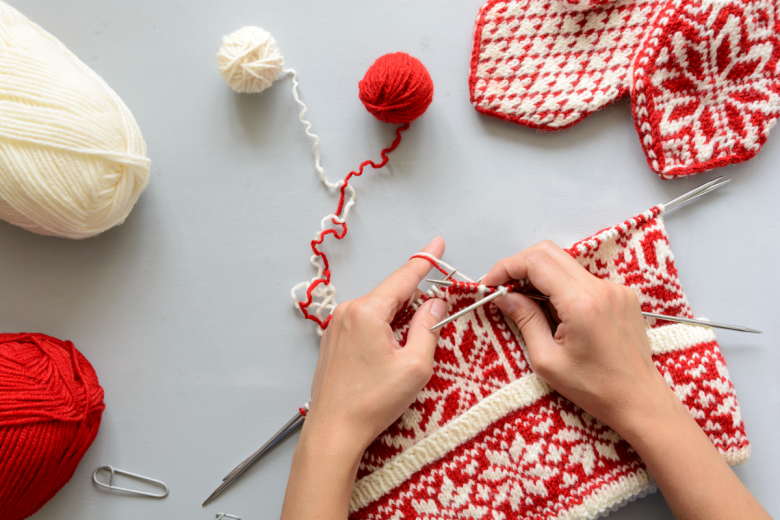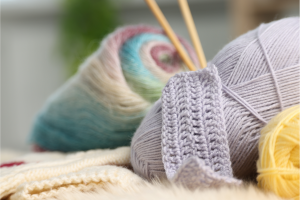Knitting is a timeless craft that has captured the hearts of many, but for those looking to take their skills to the next level, mastering complex stitches can feel like a daunting challenge. Whether you’re trying your hand at intricate lace patterns, textured cables, or more advanced techniques, the journey to mastering these stitches is often filled with moments of frustration. However, the sense of accomplishment that comes from creating something beautiful with complex designs is well worth the effort.
One of the biggest hurdles many knitters face when tackling complex stitches is the feeling of being overwhelmed. It can be easy to get lost in a pattern, make mistakes, or struggle to keep track of rows and stitch counts. The key to overcoming these challenges is understanding the basics of knitting inside and out. A solid foundation in the fundamental techniques gives you the confidence to take on more advanced projects without feeling defeated. By learning how to approach complex stitches with patience, proper planning, and the right tools, you can conquer even the most difficult patterns with ease and enjoyment.
In this guide, we will explore how to break down complex stitches step by step, share tips to avoid common pitfalls, and help you develop the mindset needed for successful knitting. Whether you’re a seasoned knitter or just starting out, the path to mastering intricate stitches begins with understanding the essentials. Let’s dive in and turn those challenging projects into accomplishments!
As you embark on the journey of mastering complex stitches, it’s important to remember that progress in knitting is often gradual. It’s common for knitters to experience setbacks or moments of doubt, but these challenges are part of the learning process. Every mistake made is an opportunity to improve, and even the most experienced knitters encounter difficulties along the way. The key is to stay persistent, embrace mistakes as learning moments, and not be afraid to start over when necessary. With each attempt, your skills will sharpen, and your confidence will grow.
Moreover, knitting is more than just following patterns—it’s about cultivating creativity and developing problem-solving skills. Complex stitches often require you to think outside the box, experimenting with different techniques and approaches. As you gain more experience, you’ll learn to adapt patterns to suit your unique style, creating pieces that reflect your personal touch. This process of experimentation not only enhances your technical abilities but also encourages artistic expression, making each project feel like a true work of art.
In the following sections, we will provide you with the tools and strategies to navigate through these challenges. By breaking down the most common complex stitches, offering detailed explanations, and suggesting practical methods to stay organized, you’ll be better equipped to handle the most intricate designs. With time, dedication, and the right mindset, you’ll be able to transform those daunting patterns into beautiful, tangible results. Whether you’re knitting for relaxation, creativity, or to make gifts for loved ones, mastering complex stitches will open up a world of possibilities and elevate your craft to new heights.
1. Breaking Down Complex Stitches: Step-by-Step Guide
One of the best ways to tackle complex stitches is to break them down into manageable parts. Complex stitches can seem intimidating at first, but when you approach them step by step, they become much easier to handle. Start by learning the basic elements of the stitch—whether it’s a cable, lace, or textured pattern—before diving into the full project. For example, if you’re learning a lace stitch, practice casting on the required number of stitches, then focus on creating the first few rows to understand the rhythm of the stitch. Once you’re comfortable, move on to more intricate parts, like incorporating increases, decreases, or different stitch types within the same pattern. Breaking down the stitch into small, repetitive steps helps build muscle memory and improves your overall knitting technique.
2. The Importance of Patience and Mindset in Knitting
Knitting is as much a mental practice as it is a physical one. Patience and a positive mindset are essential when working with complex stitches. If you rush through your project, you’re more likely to make mistakes or get frustrated. Take the time to slow down and enjoy the process, even if it feels challenging. Set realistic expectations for yourself and remember that knitting is meant to be relaxing and enjoyable. Focus on your progress, not perfection. If you encounter a mistake or mistake a stitch, don’t stress. Embrace the learning curve and allow yourself to make mistakes, knowing that they are part of the journey to mastering your craft.
3. Tools and Materials: Choosing the Right Knitting Supplies
The right tools can make all the difference when tackling complex stitches. Start by choosing high-quality yarn that suits the stitch you want to knit. For example, soft, smooth yarns work well with intricate lace patterns, while textured yarns complement cables and other 3D stitches. Your knitting needles also play a crucial role—opt for needles that feel comfortable in your hands and are the appropriate size for the yarn you’re using. Circular needles are often ideal for large projects, as they allow you to work with a lot of stitches without the risk of dropping them. Additionally, ensure that you have a good stitch marker, row counter, and a pair of scissors for cutting any loose threads.
4. How to Read Knitting Patterns for Complex Stitches
Reading knitting patterns can be confusing, especially when you’re dealing with advanced techniques. However, mastering this skill is essential for tackling complex stitches. Start by learning the common abbreviations used in patterns, such as “k” for knit, “p” for purl, or “yo” for yarn over. Patterns often provide a series of rows with specific instructions for each stitch, sometimes in a repeat format. It’s helpful to highlight or make notes on the pattern to keep track of where you are. Pay attention to any stitch symbols or diagrams provided, as these visual cues can clarify complex patterns. Practice reading smaller patterns and gradually work up to more intricate designs.
5. Common Mistakes When Knitting Complex Stitches and How to Avoid Them
When knitting complex stitches, it’s easy to make mistakes—whether it’s miscounting stitches, dropping a stitch, or forgetting a pattern repeat. One of the most common mistakes is not checking your work regularly. To avoid this, make it a habit to stop after every few rows and double-check that your stitch count matches the pattern. Another mistake is failing to understand the correct tension. Loose or tight stitches can distort the pattern, so it’s important to maintain a consistent tension throughout your project. If you’re unsure, practice on a small swatch before committing to the entire project. Finally, don’t forget to use stitch markers to mark pattern repeats or sections that need extra attention.
6. Tips for Keeping Track of Your Stitches and Rows
Keeping track of your stitches and rows is essential when working on complex patterns. Use a row counter or a piece of paper to mark off completed rows as you knit, which can help prevent confusion later. For more intricate patterns, place stitch markers at key points to indicate where repeats or pattern changes occur. Another useful trick is to write down the number of stitches on your needles after each row, so if you ever lose count, you can easily pick up where you left off. If you prefer a digital solution, apps and knitting trackers are available to help you monitor your progress in real-time.
7. How to Fix Mistakes Without Unraveling Your Entire Project
Making a mistake doesn’t mean you have to unravel your entire project. There are several techniques to fix mistakes without starting over. If you drop a stitch, use a crochet hook or your needle to pull the stitch back up to its correct position. If you find that you’ve missed a pattern repeat or made an error several rows down, you can carefully “frog” (unravel) the stitches back to the mistake, then re-knit that section. It’s also helpful to learn how to fix small mistakes, like twisted stitches or skipped yarn overs, as you go. Keep a pair of small scissors or a crochet hook nearby for easy access when fixing errors on the fly.
8. Practicing the Most Popular Complex Stitches: From Lace to Cables
The best way to become proficient in complex knitting stitches is through practice. Start with some of the most popular and versatile stitches, like lace and cables, which will teach you essential techniques for more intricate patterns. Lace knitting, which involves yarn overs and decreases, helps you learn how to create open, airy fabric, while cables introduce you to twisting stitches to create textured patterns. Once you’re comfortable with the basics, move on to other popular stitches such as bobbles, brioche, and intarsia. As you practice, your speed and confidence will increase, and you’ll be able to tackle even more challenging projects with ease.
9. Building Your Confidence: Knitting at Your Own Pace
Knitting complex stitches is a personal journey, and it’s important to build your confidence at your own pace. If a project feels overwhelming, take a step back and focus on one technique or stitch at a time. Set small, achievable goals—like completing a section of a pattern or mastering a specific stitch—and celebrate those victories. Knitting at your own pace allows you to enjoy the process without rushing, and soon, you’ll find yourself tackling complex projects with newfound confidence. Remember, knitting is meant to be fun and creative, so enjoy the journey and embrace each learning moment along the way.
Embracing the Joy of Knitting Complex Stitches
As you continue your knitting journey, embracing the joy that comes with mastering complex stitches is key to both your progress and enjoyment. While these stitches may seem challenging at first, they offer a sense of accomplishment and creative expression like no other. The intricate patterns you create will not only enhance your skill set but also give you the confidence to experiment with new techniques and designs. Remember that knitting isn’t just about finishing a project; it’s about enjoying the process, experimenting, and learning along the way. Each stitch you master brings you closer to becoming a more proficient knitter, and every project is an opportunity to expand your skills and creativity.
Patience Pays Off: How to Enjoy the Learning Process
Patience is one of the most valuable tools in any knitter’s kit. As you work through complex stitches, allow yourself the time and space to learn at your own pace. Mistakes are a natural part of the process, and rather than seeing them as setbacks, view them as valuable lessons. With each mistake, you’ll gain a deeper understanding of how to improve and avoid similar challenges in the future. The process of learning itself is just as important as the end result. Celebrate the small victories, whether it’s getting through a particularly tough row or completing a full section of a complicated pattern. By focusing on the joy of learning and improving, you’ll find that complex knitting stitches become less intimidating and more enjoyable with every project you complete.
Knitting is a journey that rewards patience, practice, and perseverance. The more you work at it, the more natural it will feel to navigate through complex stitches and patterns. So, take a deep breath, enjoy the rhythm of your needles, and embrace each step forward. With time, you’ll not only master the stitches but also discover a deeper love for the craft itself.
As you continue to expand your knitting repertoire, remember that every complex stitch you conquer brings you closer to becoming the knitter you aspire to be. It’s important to celebrate not only the finished pieces but also the effort and growth that goes into each one. The process of knitting allows you to develop patience, attention to detail, and a creative mindset. Over time, you’ll notice how your confidence grows, and your ability to take on more intricate patterns will seem less daunting. The sense of satisfaction that comes from tackling a challenging stitch and seeing your progress is incredibly rewarding.
Moreover, knitting complex stitches provides an opportunity to connect with a wider community of knitters. Sharing your experiences, learning from others, and exchanging tips can be a source of inspiration and motivation. Many knitters find joy in collaborating on projects or simply swapping advice on how to tackle a tricky stitch. This sense of community fosters a supportive environment where you can grow together, celebrate each other’s achievements, and find new ways to challenge yourself.
Ultimately, knitting is a personal journey that is shaped by your experiences, mistakes, and triumphs. The key is to keep pushing yourself while maintaining a sense of joy and curiosity. As you become more adept at intricate designs, you’ll realize that the possibilities are endless. From delicate lace shawls to bold cable sweaters, the skills you develop with complex stitches open the door to a world of creative possibilities. So, stay inspired, be patient with yourself, and continue knitting with passion. The more you immerse yourself in this craft, the more you’ll fall in love with every stitch, no matter how complex it may seem.




